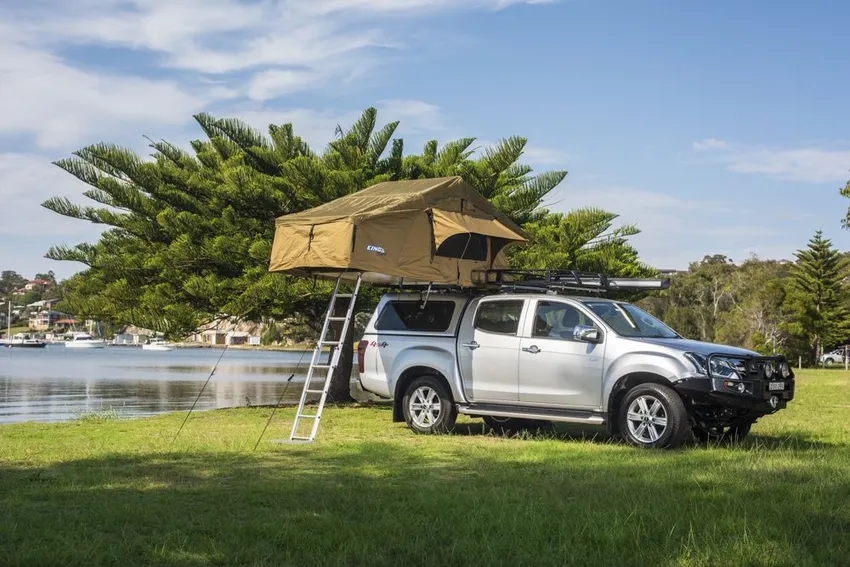Off-road camping is an adventure, allowing enthusiasts to explore rugged landscapes far from traditional campgrounds. A 4WD roof top tent makes this experience even more accessible by offering a quick and convenient way to set up camp anywhere your vehicle can take you. Mounted securely on top of your 4WD vehicle, these tents provide elevated sleeping spaces, keeping you safe from uneven terrain and wildlife. Having a properly installed rooftop tent is essential to get the most out of your off-road camping trips. This guide will walk you through choosing, installing, and camping efficiently with your 4WD roof top tent.
Choosing the Right 4WD Roof Top Tent
Factors to Consider Before Buying
When selecting the best 4WD roof top tent for your needs, there are several factors to consider to ensure it fits your vehicle and camping style. First, weight is a crucial factor. Your 4WD vehicle must be equipped with a roof rack that can support both the weight of the tent and the campers inside. Check your vehicle’s manual for roof load limits and ensure your roof rack is rated to handle the tent’s weight safely.
Size and capacity are also important. Rooftop tents come in various sizes, with most designed to sleep two to four people. If you frequently camp with family or friends, opt for a tent with a larger sleeping space. Also, consider the tent’s dimensions when folded, as you want a tent compact enough to fit on your vehicle without affecting your driving experience.
Why 4WD Supacentre Roof Top Tents are Popular
One of the most popular options on the market is the 4WD Supacentre roof top tent. Known for their affordability and durability, 4WD Supacentre roof top tents offer a cost-effective way to get into off-road camping without sacrificing quality. These tents are built with rugged materials, designed to withstand harsh weather conditions, and have features like quick-fold mechanisms, high-density foam mattresses, and weatherproof awnings.
Supacentre’s models appeal to off-road enthusiasts because they balance price and performance. They provide excellent value for money and can be installed easily on most 4WD vehicles.
Preparing for Installation
Tools and Equipment You’ll Need
Before installing your roof top tent 4WD setup, ensure you have all the necessary tools and equipment. You’ll need a reliable roof rack that is compatible with your vehicle and strong enough to support the tent. Most roof top tents, including 4WD Supacentre roof top tents, come with a ladder, mounting brackets, and bolts. In addition, you’ll need a torque wrench to tighten the bolts, ensuring everything is secure. Safety straps are also recommended to add an extra layer of stability during rough drives.
Ensuring Your 4WD Vehicle is Ready
Verifying that your 4WD vehicle is fully prepared to support a roof top tent is essential. First, check your vehicle’s roof load capacity. This information is available in the vehicle’s manual and will tell you the maximum weight your roof can safely carry. Remember that the tent’s weight and any gear you store inside will count toward this limit.
Additionally, ensure your roof rack is installed correctly and capable of handling the combined weight. Some roof racks are designed for lighter loads, so upgrading to a heavy-duty rack may be necessary. Lastly, check the vehicle’s height clearance with the tent installed, especially if you plan to park in garages or navigate areas with low-hanging obstacles.
Step-by-Step Guide to Installing a Roof Top Tent 4WD Setup
Securing the Roof Rack
The first step in installing your 4WD roof top tent is securing the roof rack to your vehicle. The roof rack must be installed securely to prevent any shifting while driving on rough terrain. Make sure to follow the roof rack manufacturer’s instructions carefully, paying attention to weight distribution and bolt tightness. It’s critical that the roof rack is aligned properly to ensure even weight distribution when the tent is mounted.
Mounting the Roof Top Tent
It’s time to mount the tent with the roof rack in place. Begin by lifting the 4WD roof top tent onto the roof rack with the help of at least one other person. These tents can be quite heavy, and lifting them without assistance can lead to damage or injury. Position the tent so it sits evenly on the rack, and line up the mounting brackets with the crossbars of the rack.
Once the tent is in position, secure it with the provided bolts and mounting hardware. Tighten the bolts with a torque wrench, ensuring they are secure but not over-tightened. The tent must be firmly attached to avoid any shifting or instability when driving off-road.
Final Adjustments and Safety Checks
After mounting the tent, make some final adjustments to ensure everything is aligned and secure. Check that the ladder is attached correctly and extends fully without wobbling. Double-check the bolts and mounting brackets, ensuring they are tightened to the manufacturer’s specifications. It’s also a good idea to test the tent by opening and closing it to ensure the folding mechanism works smoothly.
Safety checks are critical before taking your tent out on the road. Ensure that all parts are secure, and take a test drive to verify that the roof top tent 4WD setup remains stable even on uneven terrain.
Tips for Efficient Camping with a Roof Top Tent
Quick Setup and Take Down
One of the key advantages of a 4WD roof top tent is the ease of setup and take down. To maximize efficiency, practice setting up the tent before your first camping trip. Most 4WD Supacentre roof top tents are designed to be quick-fold, meaning they can be opened or packed away in just a few minutes. This saves time, especially when setting up camp at night or packing up early in the morning.
Organizing the process of setting up and taking down your tent will make it faster and less stressful. Keep the tent’s components, such as the ladder and straps, easily accessible in your vehicle to minimize hassle when you arrive at your campsite.
Optimizing Storage and Space Inside the Tent
Space management is crucial when camping with a roof top tent. Though 4WD roof top tents offer generous sleeping areas, the compact design means you’ll need to make efficient use of the available space. Consider using compact, portable gear that fits easily inside the tent without crowding the sleeping area. Storing items like sleeping bags, pillows, and clothing in collapsible containers can help keep the tent organized and comfortable.
If your tent includes an annex, use this additional space for storing larger items such as backpacks, shoes, and cooking equipment. This keeps the sleeping area clutter-free and improves overall comfort.
Staying Comfortable in Different Weather Conditions
Weather can be unpredictable, especially in remote off-road areas. 4WD roof top tents are built to withstand various weather conditions, but it’s important to be prepared. For cold weather, consider bringing insulated sleeping bags and additional layers to stay warm. Many roof top tents, including 4WD Supacentre roof top tents, come with rain covers and awnings that protect you from rain and wind. Make sure these accessories are securely attached to prevent leaks or drafts.
Ventilation is also essential in warm weather. Ensure your tent has adequate airflow by opening windows or vents to prevent condensation build-up and keep the interior cool.
Conclusion
Setting up a roof top tent 4WD is one of the best ways to enhance your off-road camping experience. With the right tools, proper preparation, and a reliable tent like the 4WD Supacentre roof top tent, you can enjoy the freedom and convenience of sleeping wherever your 4WD vehicle takes you. Whether exploring remote trails or camping by the beach, a well-installed 4WD roof top tent provides comfort, safety, and ease for any adventure.




